By Susan Belsinger
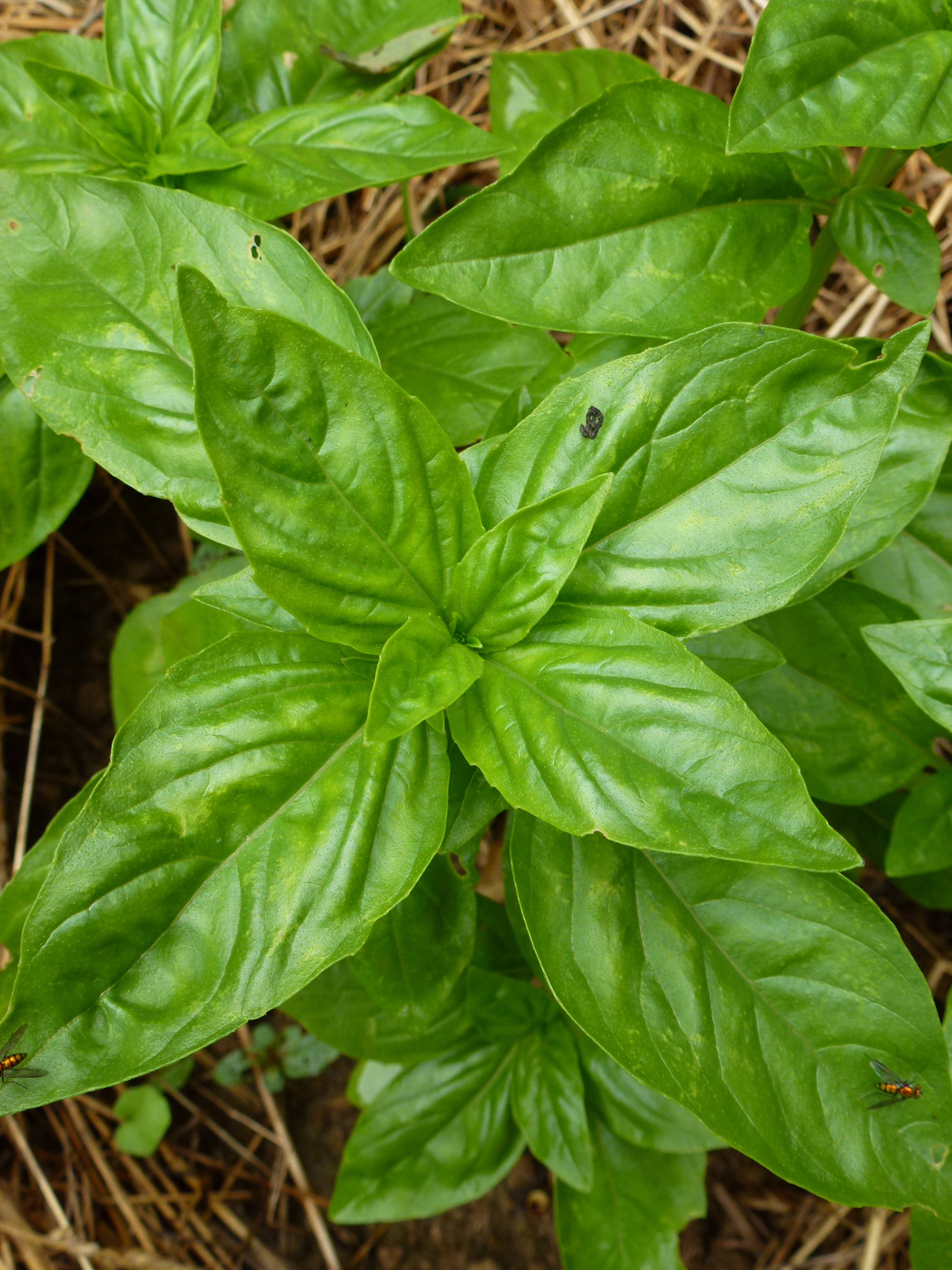 I fell in love with basil upon my first bite of pesto in bella Italia back in the early 70s. The aroma and taste of Ocimum basilicum ‘Genoa Green’ or ‘Genovese’ caught me unaware and captivated me—and I began to grow and cook with it. I learned the art of making pesto with a mortar and pestle from an Italian aristocrat in the hills of Tuscany.
I fell in love with basil upon my first bite of pesto in bella Italia back in the early 70s. The aroma and taste of Ocimum basilicum ‘Genoa Green’ or ‘Genovese’ caught me unaware and captivated me—and I began to grow and cook with it. I learned the art of making pesto with a mortar and pestle from an Italian aristocrat in the hills of Tuscany.
In 1980 when Carolyn Dille and I were writing Cooking with Herbs, we met herb grower Thomas DeBaggio. We three became fast friends and enthusiasts about all things herbal, Italian, and involving good food and writing. In 1995, Tom invited me to write a book about basil with him. His ulterior motive was that I had a lot of growing space in my zone 7 Maryland garden, whereas he had a small backyard and two greenhouses in Arlington, Virginia. He germinated over 90 different types of basil from seeds we gathered from seed companies around the U.S. and Italy, and from seeds brought back to us from Italy and even India.
Tom delivered about 400 plants to me, and I transplanted the baby basils in my garden. It was an extraordinarily aromatic summer. We were looking for the best culinary cultivars, so we had many types of sweet green or bush basil that were similar. However, there were also unusual basil cultivars, like ‘Sweet Dani’ and ‘Magical Michael’ given to us by Dr. Jim Simon at Rutgers University. African blue basil (Ocimum kilimandscharicum × basilicum) was a gorgeous, healthy, bi-colored ornamental with not much culinary use, while O. selloi smelled and tasted like green bell peppers; the new-to-me Tulsi (holy or sacred basil) smelled medicinal and perfume-like, not very well-suited for the kitchen.
 My job was describing the flavor of each basil; I spent a lot of time with my notebook on my garden stool, smelling and tasting basils. I could only do a few a day, because once the herbal oils penetrated my palate, I could not decipher the flavor of each individual plant very well. I found that for clearing my palate, a stoned-wheat thin cracker was better than water, milk, or a coffee bean.
My job was describing the flavor of each basil; I spent a lot of time with my notebook on my garden stool, smelling and tasting basils. I could only do a few a day, because once the herbal oils penetrated my palate, I could not decipher the flavor of each individual plant very well. I found that for clearing my palate, a stoned-wheat thin cracker was better than water, milk, or a coffee bean.
Being somewhat of an herbal newbie, I recorded my smell and taste findings using adjectives from anise- or licorice-like to lemony or minty to grass-like, bitter, sweet, etc. We sent leaf tips and flowers of each different selection to Dr. Art Tucker of Delaware State University to analyze the chemical constituents in his laboratory for us. To my surprise and pleasure, when I described citrus, there was actual citral* present; when I used licorice or anise descriptors, there was methyl chavicol† present; and if I found spice, there was eugenol‡, and so on. From that experience, I was initiated into the world of chemical constituents and have never turned back!
Basil: An Herb Lover’s Guide was published by the visionary Linda Ligon, owner and editor of Interweave Press, in 1996. It took Tom and me two years to grow, research, write, and test recipes for the book. (It was challenging to get the book away from Tom, because he kept tweaking it or adding another basil, etc.) We both had our favorite herbs, two of which we agreed upon wholeheartedly. ‘Genoa Green’ (‘Genoa Green Migliorato’ or ‘Genoa Green Improved’) was our hands-down favorite for making pesto and antipasto di pomodoro e mozzarella: wonderfully balanced in flavor, it stars in summer meals, especially with tomatoes and pasta dishes. ‘Mrs. Burns’ Lemon’ basil (Ocimum ×africanum) was our first choice of the lemon basils; very strong in lemon with really no anise/licorice flavors, it has many uses from savory to sweet, a favorite herb for making syrup.
 I’ve continued to grow ‘Genoa Green’ and ‘Mrs. Burns’ Lemon’ for some 30 years now and have not missed a single summer without these two ultimate flavor-enhancing basils. I grow plenty of each so I have them to dine upon in season and enough to freeze in herbal pastes to make syrups, salts, and sugars to use the rest of the year. Lemon basil gelato is one of the most ethereal ice creams that I have ever eaten.
I’ve continued to grow ‘Genoa Green’ and ‘Mrs. Burns’ Lemon’ for some 30 years now and have not missed a single summer without these two ultimate flavor-enhancing basils. I grow plenty of each so I have them to dine upon in season and enough to freeze in herbal pastes to make syrups, salts, and sugars to use the rest of the year. Lemon basil gelato is one of the most ethereal ice creams that I have ever eaten.
I must admit, I didn’t really like Tulsi (holy or sacred basil), Ocimum tenuiflorum (now O. sanctum) very much; it took me years to warm to it. Although once I began growing it in earnest, it began to grow on me. Researching this herb native to and revered in India, I found “the intricacies of morphology and chemistry cannot mask the reverence in which these basils are held, or their long and intimate association with the people of India and their dreams. Holy basil is a symbol of love and fidelity and is woven through many daily rituals.”
Currently, Tulsi is my go-to herbal adaptogen, and I use it daily. I make tea or a tincture of fresh leaves and flowers infused in VSOP brandy—my favored and most-used mellowing tincture. I use the hydrosol and essential oil in bath and body care products. Ocimum sanctum has become an herbal ally.
As the summer season is here, it is time to plant your basil. I highly recommend that you grow this trio of basils. If you already know them, then plant a surplus to preserve and share. If you are new to any of them, then be sure to broaden your flavor horizons—you will be glad that you did!
Watch Susan making pesto in her kitchen: https://www.youtube.com/watch?v=FjkTwiWEWB8
Harvesting: Don’t just pinch off the tips – keep plants pruned for best growth
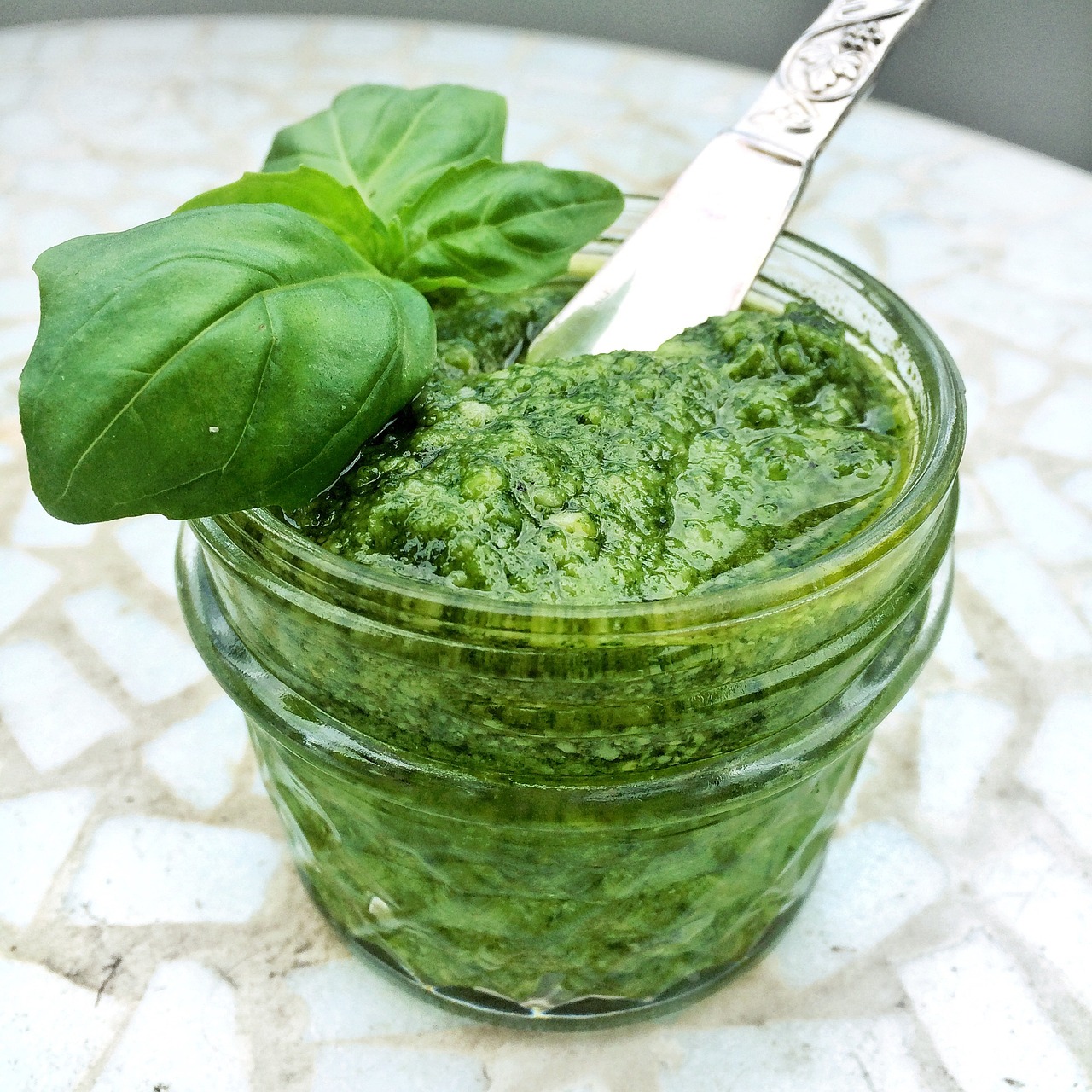 The most important thing about growing basil is keeping it cut back in order to have a continual harvest of fresh leaves throughout the season. I am diligent about this, and I get a huge yield of leaves throughout the harvest season; it keeps the basil’s flavor and aroma at its peak, rather than becoming bitter. In my zone 7 garden, I set basil out about mid- to the end of May. When I transplant the new tender plants, I cut them back just above the bottom two sets of leaves. This early pruning seems a bit drastic, but it will provide for more growth early on.
The most important thing about growing basil is keeping it cut back in order to have a continual harvest of fresh leaves throughout the season. I am diligent about this, and I get a huge yield of leaves throughout the harvest season; it keeps the basil’s flavor and aroma at its peak, rather than becoming bitter. In my zone 7 garden, I set basil out about mid- to the end of May. When I transplant the new tender plants, I cut them back just above the bottom two sets of leaves. This early pruning seems a bit drastic, but it will provide for more growth early on.
Depending on the weather and the growth progress of the plants, I prune the plants back to above the bottom two sets of leaves about every 4 weeks, so the next pruning takes place mid- to the end of June. This pruning/harvesting process is repeated every month, or if the plants show any sign of a flower bud throughout the growing season. This way, I harvest about 15 to 25 cups of basil leaves per plant and have delicious tasty basil in September rather than bitter spent leaves.
So often, people tell me that their basils just didn’t do well. The first thing I ask them is did they keep them cut back. Of course, if you just pinch off the tips or the flowers, the plants will keep trying to make flowers in order to set seed. The leaf yield will be small and the plants will become bitter tasting. Get serious—keep those plants pruned, and eat basil! 
* Citral is a mixture of two organic aldehydes found in some lemon-scented essential oils.
† Methyl chavicol (syn. estragole) “is a sweet-smelling ether found in essential oils of anise, tarragon, and basil” (https://material-properties.org/estragole/, accessed 16 June, 2024).
‡ Eugenol “is a colorless to pale yellow, aromatic oily liquid extracted from certain essential oils especially from clove, nutmeg, cinnamon, basil and bay leaf” (https://en.wikipedia.org/wiki/Eugenol, accessed 16 June, 2024).
Photo Credits: 1) Ocimum basilicum ‘Genoa Green’ (‘Genovese Verde Migliorato’ basil) (courtesy of the author); 2) Ocimum sanctum (formerly O. tenuiflorum)–Tulsi, sacred or holy basil (courtesy of the author); 3) Ocimum ×africanum ‘Mrs. Burns’ Lemon’ (courtesy of the author); 4) Basil pesto (Pixabay); 5) Basil flowers (Pixabay)
 Susan Belsinger lives an herbal life, whether she is gardening, foraging, herborizing, photographing, teaching, researching, writing, or creating herbal recipes for the kitchen or apothecary—she is passionate about all things herbal. Referred to as a “flavor artist,” Susan delights in kitchen alchemy—the blending of harmonious foods, herbs, and spices—to create real, delicious food, as well as libations, that nourish our bodies and spirits and titillate our senses. There is nothing she likes better than an herbal adventure, whether it’s a wild weed walk, herb conference, visiting gardens or cultivating her own, or the sensory experience of herbs through touch, smell, taste, and sight.
Susan Belsinger lives an herbal life, whether she is gardening, foraging, herborizing, photographing, teaching, researching, writing, or creating herbal recipes for the kitchen or apothecary—she is passionate about all things herbal. Referred to as a “flavor artist,” Susan delights in kitchen alchemy—the blending of harmonious foods, herbs, and spices—to create real, delicious food, as well as libations, that nourish our bodies and spirits and titillate our senses. There is nothing she likes better than an herbal adventure, whether it’s a wild weed walk, herb conference, visiting gardens or cultivating her own, or the sensory experience of herbs through touch, smell, taste, and sight.
Susan is a member of the Potomac and the Ozark Units of The Herb Society of America and served as Honorary President (2018 – 2020). Her latest publication, Growing Your Own Herbs: The 40 Best Culinary Varieties for Home Gardens (2019, Timber Press), co-authored by Susan Belsinger and Arthur O. Tucker, is a revised, concise version for gardeners and cooks of The Culinary Herbal: Growing & Preserving 97 Flavorful Herbs (2016). Her latest book, the perfect bite, was published in 2022. After blogging for Taunton Press’ www.vegetablegardener.com for the past eight years, those blogs (over 484 to be exact) are now posted at https://www.finegardening.com/?s=susan%20belsinger. To order books, go to susanbelsinger.com.


 One of the main things that I love about the summer season is the many wild and wonderful flavors in the herb garden. While my chervil and sweet cicely have come and nearly gone since they have set seed, dill and fennel are showing out, and anise hyssop, basil, and tarragon are coming on strong in my zone 7, Maryland garden.
One of the main things that I love about the summer season is the many wild and wonderful flavors in the herb garden. While my chervil and sweet cicely have come and nearly gone since they have set seed, dill and fennel are showing out, and anise hyssop, basil, and tarragon are coming on strong in my zone 7, Maryland garden.  Anise (Pimpinella anisum)
Anise (Pimpinella anisum) Anise hyssop (Agastache foeniculum)
Anise hyssop (Agastache foeniculum) Basil (Ocimum spp.)
Basil (Ocimum spp.)
 Dill (Anethum graveolens)
Dill (Anethum graveolens) Fennel (Foeniculum vulgare)
Fennel (Foeniculum vulgare) French Tarragon (Artemisia dracunculus ‘Sativa’)
French Tarragon (Artemisia dracunculus ‘Sativa’) Licorice (Glycyrrhiza glabra)
Licorice (Glycyrrhiza glabra) Mexican tarragon (Tagetes lucida)
Mexican tarragon (Tagetes lucida) Sweet cicely (Myrrhis odorata)
Sweet cicely (Myrrhis odorata)

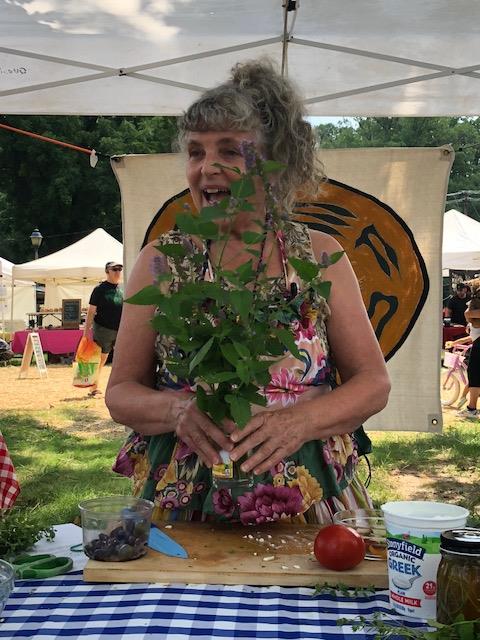 Foliage of these aromatic plants are used in recipes around the globe and will brighten a salad, soup, sauce, any egg dish and are tasty with pasta, grains, vegetables, fish, and fowl. Flowers have a surprising amount of flavor due to concentrated essential oils—use them as a garnish on salads or beverages—or put a flower umbel in your pickle jar. I use leaves and blooms in making herb butters, vinegars, and syrups. The famous French blend of
Foliage of these aromatic plants are used in recipes around the globe and will brighten a salad, soup, sauce, any egg dish and are tasty with pasta, grains, vegetables, fish, and fowl. Flowers have a surprising amount of flavor due to concentrated essential oils—use them as a garnish on salads or beverages—or put a flower umbel in your pickle jar. I use leaves and blooms in making herb butters, vinegars, and syrups. The famous French blend of  These are a crisp butter cookie with a crunch of almond and a hint of anise. They are tasty with a cup of tea or are lovely accompaniments to fresh seasonal fruit or ice cream. For a heartier, healthier cookie, I use a scant cup of whole-wheat pastry flour in place of one of the cups of unbleached flour.
These are a crisp butter cookie with a crunch of almond and a hint of anise. They are tasty with a cup of tea or are lovely accompaniments to fresh seasonal fruit or ice cream. For a heartier, healthier cookie, I use a scant cup of whole-wheat pastry flour in place of one of the cups of unbleached flour.  Susan Belsinger lives an herbal life, whether she is gardening, foraging, herborizing, photographing, teaching, researching, writing, or creating herbal recipes for the kitchen or apothecary—she is passionate about all things herbal. Referred to as a “flavor artist,” Susan delights in kitchen alchemy—the blending of harmonious foods, herbs, and spices—to create real, delicious food, as well as libations, that nourish our bodies and spirits and titillate our senses. There is nothing she likes better than an herbal adventure, whether it’s a wild weed walk, herb conference, visiting gardens or cultivating her own, or the sensory experience of herbs through touch, smell, taste, and sight.
Susan Belsinger lives an herbal life, whether she is gardening, foraging, herborizing, photographing, teaching, researching, writing, or creating herbal recipes for the kitchen or apothecary—she is passionate about all things herbal. Referred to as a “flavor artist,” Susan delights in kitchen alchemy—the blending of harmonious foods, herbs, and spices—to create real, delicious food, as well as libations, that nourish our bodies and spirits and titillate our senses. There is nothing she likes better than an herbal adventure, whether it’s a wild weed walk, herb conference, visiting gardens or cultivating her own, or the sensory experience of herbs through touch, smell, taste, and sight. Basil,
Basil,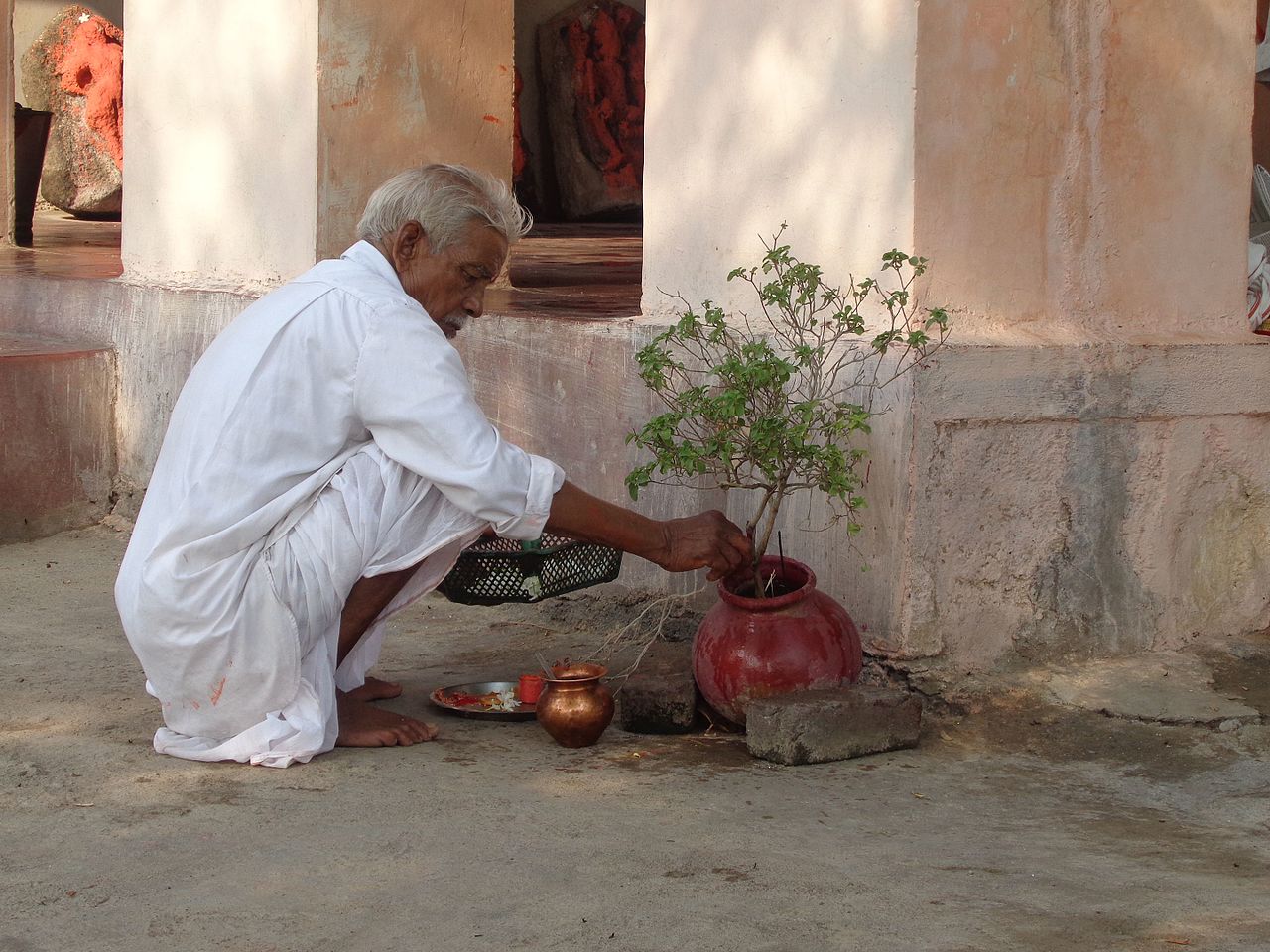 Although named by the Greeks, basil originated in India 5,000 years ago. In India today, the herb is considered a sacred herb. Holy basil,
Although named by the Greeks, basil originated in India 5,000 years ago. In India today, the herb is considered a sacred herb. Holy basil,  From India, basil spread to Egypt, where the herb was used for embalming and has been found buried with the pharaohs. The herb then moved on to Rome and southern Europe, where the Romans fell in love with it. In Italy, basil was considered a sign of love. If young girls were seeking a suitor, they would place a pot of basil on their windowsill. If a potential suitor showed up with a sprig of basil, the girl would love him forever.
From India, basil spread to Egypt, where the herb was used for embalming and has been found buried with the pharaohs. The herb then moved on to Rome and southern Europe, where the Romans fell in love with it. In Italy, basil was considered a sign of love. If young girls were seeking a suitor, they would place a pot of basil on their windowsill. If a potential suitor showed up with a sprig of basil, the girl would love him forever. 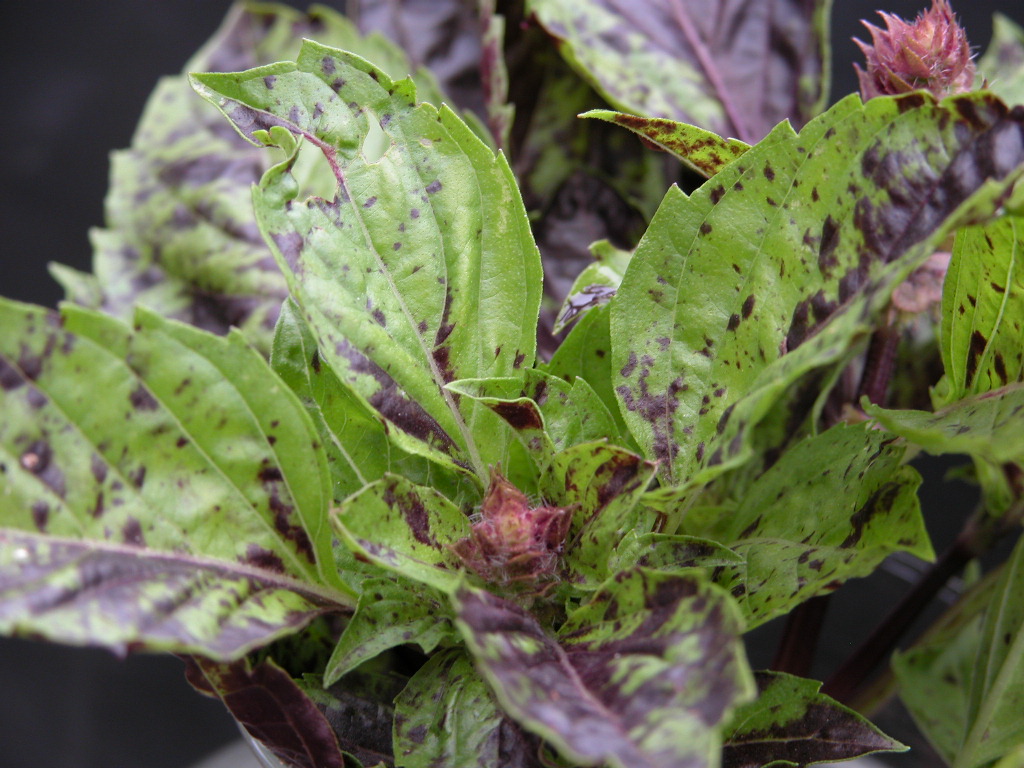 Italy became the home of pesto, which basil has made famous. “Pesto was created by the people of Genoa to highlight the flavor of their famous basil. Using a mortar and pestle, they combined simple ingredients to make one of the world’s most famous pasta sauces” (Blackman, 2010). The simple sauce contains only basil, pine nuts, olive oil, garlic, and parmigiano-reggiano cheese. Pesto is still a very popular sauce for pasta or crackers, especially in the summer, when fresh basil is plentiful.
Italy became the home of pesto, which basil has made famous. “Pesto was created by the people of Genoa to highlight the flavor of their famous basil. Using a mortar and pestle, they combined simple ingredients to make one of the world’s most famous pasta sauces” (Blackman, 2010). The simple sauce contains only basil, pine nuts, olive oil, garlic, and parmigiano-reggiano cheese. Pesto is still a very popular sauce for pasta or crackers, especially in the summer, when fresh basil is plentiful.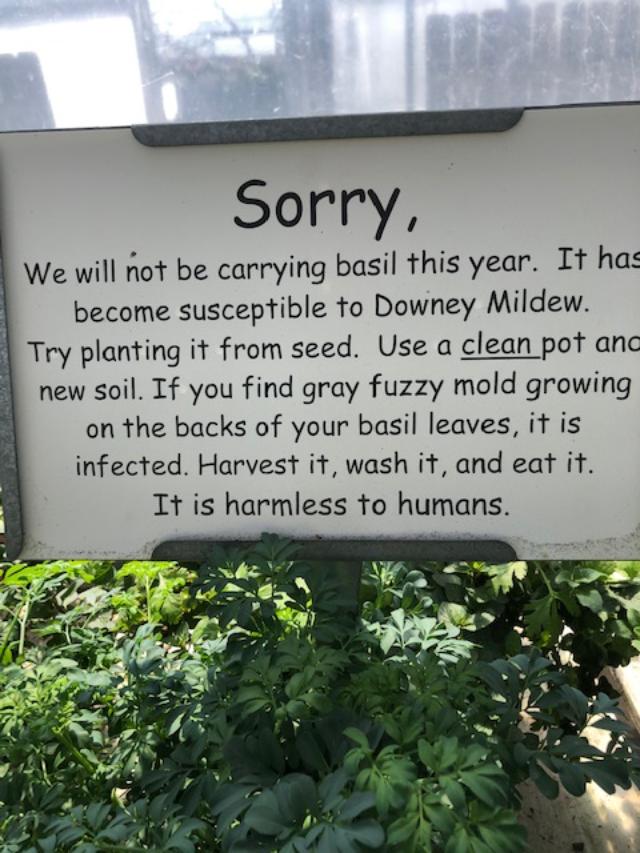 Basil, a sun-loving member of the mint family, is an annual herb that thrives in summer heat. In fact, it will languish if planted in the garden before temperatures reach a consistent 70 plus degrees. Frequent harvesting of the leaves before flowers appear prolongs its growing season. It can be propagated by seed or cuttings. However, it is very susceptible to downy mildew, which researchers are constantly trying to overcome by breeding more disease-resistant varieties. The new gene editing CRISPR technology may show a promising solution to this problem (Riccio, 2022).
Basil, a sun-loving member of the mint family, is an annual herb that thrives in summer heat. In fact, it will languish if planted in the garden before temperatures reach a consistent 70 plus degrees. Frequent harvesting of the leaves before flowers appear prolongs its growing season. It can be propagated by seed or cuttings. However, it is very susceptible to downy mildew, which researchers are constantly trying to overcome by breeding more disease-resistant varieties. The new gene editing CRISPR technology may show a promising solution to this problem (Riccio, 2022).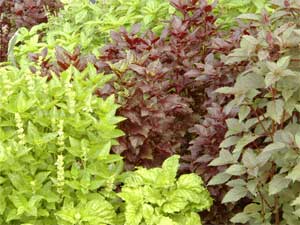 Basil is not usually considered a medicinal herb, but it was used medicinally in the time of Hippocrates who prescribed it as a tonic for the heart and to treat vomiting and constipation. Pliny the Elder commented that it was good for lethargy and fainting spells, headaches, flatulence, and other digestive issues (Pliny, 1855). China and India have a long history of using basil as a medicinal herb as well.
Basil is not usually considered a medicinal herb, but it was used medicinally in the time of Hippocrates who prescribed it as a tonic for the heart and to treat vomiting and constipation. Pliny the Elder commented that it was good for lethargy and fainting spells, headaches, flatulence, and other digestive issues (Pliny, 1855). China and India have a long history of using basil as a medicinal herb as well. So, do enjoy fresh basil this summer. Remember to dry some for the winter, freeze the leaves, or combine chopped leaves with water and freeze in an ice cube tray for later use. However, you should take careful consideration before putting basil on your windowsill lest you attract an unwanted suitor.
So, do enjoy fresh basil this summer. Remember to dry some for the winter, freeze the leaves, or combine chopped leaves with water and freeze in an ice cube tray for later use. However, you should take careful consideration before putting basil on your windowsill lest you attract an unwanted suitor. The chef looked up at me, astonished, with a crumpled up Genovese basil leaf in his hand. “Oh my god, that smells fantastic,” he said, laughing and shaking his head. We had just gone over proper basil harvesting technique, and I had invited him to pinch off a leaf of the basil he had just grown for the first time inside the restaurant. It’s funny, even chefs at nicer restaurants get used to subpar quality when it’s all they have access to. It’s just so difficult for chefs to get really fresh, high quality herbs in the consistent, predictable quantities they need to run a kitchen. So, they settle. How did he grow basil inside the restaurant? We’ll get to that in a minute.
The chef looked up at me, astonished, with a crumpled up Genovese basil leaf in his hand. “Oh my god, that smells fantastic,” he said, laughing and shaking his head. We had just gone over proper basil harvesting technique, and I had invited him to pinch off a leaf of the basil he had just grown for the first time inside the restaurant. It’s funny, even chefs at nicer restaurants get used to subpar quality when it’s all they have access to. It’s just so difficult for chefs to get really fresh, high quality herbs in the consistent, predictable quantities they need to run a kitchen. So, they settle. How did he grow basil inside the restaurant? We’ll get to that in a minute.  This chef is now able to grow top-notch herbs inside his restaurant, just feet away from the kitchen, because he has a sophisticated hydroponic growing system called a Farmshelf.
This chef is now able to grow top-notch herbs inside his restaurant, just feet away from the kitchen, because he has a sophisticated hydroponic growing system called a Farmshelf. busy restaurant staff with no in-ground space to grow high quality produce year-round. Additionally, since it is kept nice and clean, this method prevents just about any pest or plant pathogen you can think of.
busy restaurant staff with no in-ground space to grow high quality produce year-round. Additionally, since it is kept nice and clean, this method prevents just about any pest or plant pathogen you can think of. 

 It seems almost sacrilegious to be talking about spring already, but that is exactly what gardeners do—they plan for the season ahead.
It seems almost sacrilegious to be talking about spring already, but that is exactly what gardeners do—they plan for the season ahead. Cardinal basil is also a culinary basil, although I have to admit that I have not tried it yet. Others report that it has the same basil flavor with a slight anise, pungent flavor. The young flowers make a colorful addition to salads or vegetable dishes.
Cardinal basil is also a culinary basil, although I have to admit that I have not tried it yet. Others report that it has the same basil flavor with a slight anise, pungent flavor. The young flowers make a colorful addition to salads or vegetable dishes.

 Say basil and people think of a plant with large, cupped green leaves and pesto. They probably envision sweet basil, the poster child for this plant. But, many different types exist. A member of the mint family, the basil genus Ocimum has more than 30 species. And, most of the basils we grow are some type of Ocimum basilicum; within this species, there are more than 40 cultivars. All have garden and home use.
Say basil and people think of a plant with large, cupped green leaves and pesto. They probably envision sweet basil, the poster child for this plant. But, many different types exist. A member of the mint family, the basil genus Ocimum has more than 30 species. And, most of the basils we grow are some type of Ocimum basilicum; within this species, there are more than 40 cultivars. All have garden and home use.

 Container plant. All types of basil can be used as container plants either for green, variegated, or purple foliage, or colorful flower heads. Basil comes in different sizes from 8 inches to 4 feet so make sure the maximum height is in proportion to the container. Companion plants must also like well-drained soil and the container should have drainage holes. I had a few extra holy basil plants that I stuck in the same container as my bush beans and I have seen containers of basil and ornamental purple peppers.
Container plant. All types of basil can be used as container plants either for green, variegated, or purple foliage, or colorful flower heads. Basil comes in different sizes from 8 inches to 4 feet so make sure the maximum height is in proportion to the container. Companion plants must also like well-drained soil and the container should have drainage holes. I had a few extra holy basil plants that I stuck in the same container as my bush beans and I have seen containers of basil and ornamental purple peppers. Magnet for pollinators, beneficial insects, and birds. All basils, if left to flower, have small flowers that attract beneficial insects and bees. Birds, such as goldfinches, love the seed heads. I grow lemon basil in a container on the deck to attract the finches so I can see the birds up close through my kitchen window.
Magnet for pollinators, beneficial insects, and birds. All basils, if left to flower, have small flowers that attract beneficial insects and bees. Birds, such as goldfinches, love the seed heads. I grow lemon basil in a container on the deck to attract the finches so I can see the birds up close through my kitchen window. Baking. Basil has been used to flavor cookies, pound cakes, and breads (rolls, muffins, flatbreads). I use the sweet basil for flatbreads and dinner rolls and the lemon, lime, or cinnamon for flavoring pound cakes. Basil flowers are edible and can be candied and used as decorations on desserts.
Baking. Basil has been used to flavor cookies, pound cakes, and breads (rolls, muffins, flatbreads). I use the sweet basil for flatbreads and dinner rolls and the lemon, lime, or cinnamon for flavoring pound cakes. Basil flowers are edible and can be candied and used as decorations on desserts.